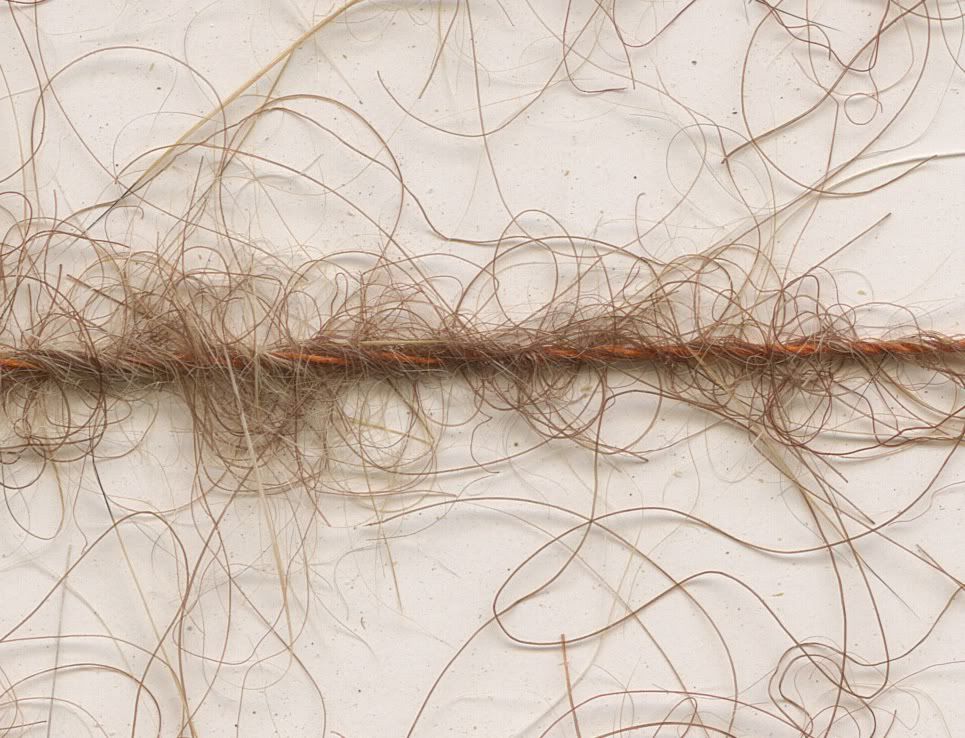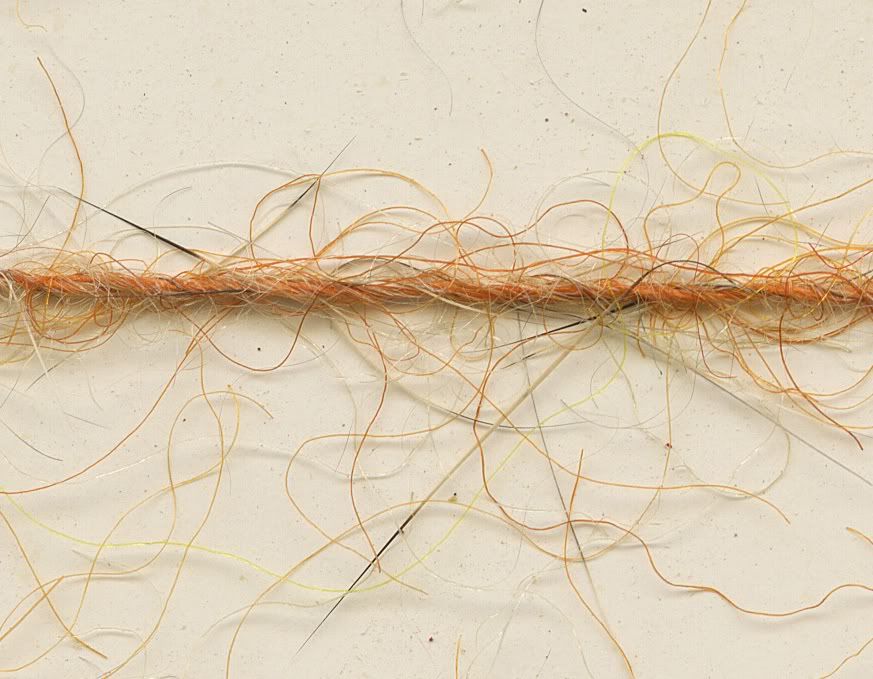Page 1 of 3
Questions, questions, questions .....
Posted: Thu Apr 05, 2012 5:04 pm
by hankaye
Howdy All;
My question mechinism has kicked in again. So, instead of hijacking another thread...
In a recient thread gingerdun asked Hans;
'" Since you didn't mention split-thread, is the Argentinian Hare touch-dubbed on the brown Uni-thread? "
To which Hans replied;
" Nope - I would have put that in the recipe if it had been Simple, traditional noodle - twisted around the thread. "
Ok, here we go, I understand about the 'touchdubbing' being a thin wispy mood setter. One of them "come hither big fella"
kind of things...
There have been several discussions that included the use of the dubbing block and the use of the 'pre-made roll your own's'.
There have been much mention of, as Hans put it, " traditional noodle " .
Question; What, if any, difference is there between a 'traditionl noodle and a 'pre-made roll your own' from a dubbing block
Please include the reasons you may have for your prefrence of one over the other or if no prefrence...... Also, if anyone uses
both is there a reason why to choose one over the other when tying certian flys???
Thanks for everyone's input...
hank
Re: Questions, questions, questions .....
Posted: Thu Apr 05, 2012 6:49 pm
by DUBBN
I prefer doing all my tying at the vise. I dont have the patience or desire to use a block. I dont see how a block would put more fish in my creel so I do not use it. Just my preferance.
Re: Questions, questions, questions .....
Posted: Thu Apr 05, 2012 8:08 pm
by Jerry G
Hank I have yet to use a dubbing block. I do on occasion use the split thread technique or a dubbing loop which I suspect gives one a similar result as the dubbing block. The block simply allows you to build what you intend to use as bodies ahead of time. Each of the above techniques will offer you I think a better opportunity to acheive a translucent body for a fly as opposed to a traditional noodle. Of course this is just my take on the subject others may have different ideas.
Regards, Jerry
Re: Questions, questions, questions .....
Posted: Thu Apr 05, 2012 8:30 pm
by chase creek
IMHO (I'm starting to catch on to this lingo, thanks to my 4 yr old granddaughter), the "traditional noodle" can give you a tighter body, where a dubbing loop or dubbing brush will spawn a more brushy or spikey body. As far as I can tell, the only difference between a bush made with a block and a dubbing loop done on the hook is just that - the dubbing loop is made on the run, where brushes made with a block are made ahead of time and stored for future use. I can see that perhaps the dubbing block could yield more consistant results as far as uniformity of the brushes, but I prefer to use a loop on the run. BUT; to each his own. I even made a block a while back and forced myself to use it for a while, but eventually returned to the dubbing loop made on the hook. Just the cowboy in me, I guess.
Re: Questions, questions, questions .....
Posted: Thu Apr 05, 2012 9:29 pm
by gingerdun
As you know by now, I am one of the more inexperienced tiers here. But I have some information about why Pete Hidy and Jim Leisenring spun their bodies and stored them on cards.
Jim stated that flies constructed this way were more durable, but this seems to be of less importance today than it was for Jim.
He and Pete also thought that it was easier to get a subtle taper to the body with a dubbing loop, but people skilled with split thread might argue with them.
Pete liked to mix different furs together, and once he had a batch mixed, he wanted to make a number of bodies while he had the fur out on the table, rather than put it away, and then have to search for the dubbing mix next time he wanted to tie a fly with it. Here are scans showing the colors and textures of pre-spun bodies made by Pete Hidy on the block.






No doubt these effects could be achieved with other methods, but Pete liked to stockpile these custom-blended bodies ahead of time to speed up the process of tying. I know that Pete was always happy to teach his method to visitors, but he applauded other approaches, and would never criticize anybody who chose a tying technique different from his.
Lance
Re: Questions, questions, questions .....
Posted: Thu Apr 05, 2012 10:45 pm
by hankaye
Howdy All;
Getting some good responces so far. Can't wait for the earily birds way off to the East
to sound in on this...
Thanks to those of you that have taken the time to not only read but also post replies...
hank
Re: Questions, questions, questions .....
Posted: Fri Apr 06, 2012 12:13 am
by Mataura mayfly
Depends how far East you go, mid afternoon here.
Have tried all the above, favour none in particular..... I can tie a bad fly with any of them!

Having said that, it is a horses for courses thing. On one side your personal preference and what works best for you and on the other (i find) it depends what size hook your tying on.
I find it hard to form bodies on flies smaller than say #14 standard shank length with a block formed dubbing twist made off the hook. What this method is letting me do though, in a more controled manner, is "design" fly bodies by moving or placing the fur or dubbing where you want it, in the amount you want it and in the colours that suit the tie you are trying to emulate.
It is a lot easier (for me) to mix and match- chop and change with the dubbing block. Add some gauge marks and you can soon judge how much dubbing you need for whichever length of hook.
For split thread, I like it and use it, but generally for one colour dubbing or pre mixed. It also depends on the thread of choice on the day, some split nice and easy- others are a nasty thread, invented by some comercial tying outfit that would rather you buy their ready made flies!

Some threads fray or break when I go anywhere near them with a needle or even threaten to try to split them. I feel it is a good method for getting spikey dubbing under control- yet still not loosing the spikey effect (if that makes sense?).
Dubbing noodles. Well it is the way we all learnt to tie flies (well it was for me),good results with synthetics, not so good with natural stuff like Hare mask and Seal. Not as secure of a way of attaching dubbing to the thread and is more durable if ribbed.
All the above is just a personal opinion on the methods from a fairly inexperienced tier. Others will have perfected noodles that don't need ribbed or multi coloured bodies formed in a dubbing loop on the hook. Me, I will just blunder along the way I do and tie flies that take the odd trout now and then and be happy doing it.


Re: Questions, questions, questions .....
Posted: Fri Apr 06, 2012 3:25 am
by Hans Weilenmann
Lance,
Interesting response and even more so images.
You puzzled me with one statement:
Jim stated that flies constructed this way were more durable, but this seems to be of less importance today than it was for Jim.
Can you explain both parts of that statement in a bit more detail, please, so I do not have to start out with the proverbial "assume"

Cheers,
Hans W
Re: Questions, questions, questions .....
Posted: Fri Apr 06, 2012 5:38 am
by gingerdun
Hans Weilenmann wrote:
Jim stated that flies constructed this way were more durable, but this seems to be of less importance today than it was for Jim.
Can you explain both parts of that statement in a bit more detail, please, so I do not have to start out with the proverbial "assume"

Hans, Leisenring began chapter 7, "Spinning a Body," with these words:
THE PURPOSE of this chapter is to explain the best method of
spinning a body which will stand up under the gnawing of trout’s
teeth. A body which has been scraped down and worn well—practically
worn out—is better than a new one for catching fish, so it is well to
construct them for long wear. . . . A body spun in the following manner is practically indestructible,
enables the fly tier to spin the hard, wiry materials such as
seal’s fur without difficulty, and gives the fly a good undercolor through
the medium of your tying silk.
Quite a few forum folk weighed in on the durability question, with the consensus being that it was not as important now as back in the days of Leisenring and his predecessors. Here is the link to that discussion.
http://www.flymphforum.com/viewtopic.ph ... durability
And MM, that was a great post. Really makes sense. Thanks for taking the time to explain your experience.
Best,
Lance
Re: Questions, questions, questions .....
Posted: Fri Apr 06, 2012 6:17 am
by gingerdun
Hans,
One more thing. A disadvantage of the spun body is that it requires silk, which is less strong than synthetics such as Benecci. The problem with the synthetic threads is that they don't set and hold the rope twist as firmly as silk does.
Of course, with split thread, you don't have to worry about the spun dubbing loop setting overnight. I was skeptical at first about the strength of your split thread bodies, but because you use that amazingly tough Benecci thread, it is probably as durable as Leisenring's dubbing loop. In addition, you get a slimmer profile, closer to the North Country Spiders, but with a little buggy texture. Very fine indeed.
Lance





